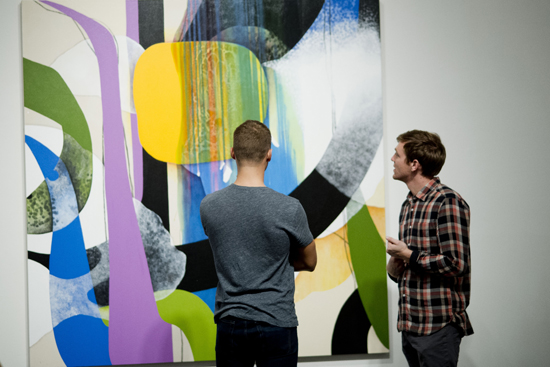Abstract Art for the 21st Century
BUAG show brings powerhouse of artists to campus
Love it or hate it, everyone has an opinion about abstract art. Popularized in the United States by such painters as Jackson Pollock, Mark Rothko, and Willem de Kooning, the form is often regarded as a mid-20th-century phenomenon. It’s not.
A new show at the Boston University Art Gallery (BUAG) at the Stone Gallery demonstrates that abstract art is alive and well, in the work of nine influential artists, including Dana Frankfort, a College of Fine Arts assistant professor of visual arts. The exhibition, says BUAG director and chief curator Kate McNamara, is meant to “open up a conversation about contemporary abstract painting.”
The first work to catch the eye on entering the gallery is Polly Apfelbaum’s Miss America, which consists of two strips of sequined fabric placed at an angle in the center of the gallery floor. The work evokes the runways used by beauty pageant contestants and models, wittily conjuring up images of swimsuit competitions and tiaras. Jenny Monick’s nearby abstract canvases use formal repetition and geometry, painted lines, and shapes “to refute familiar ideas of what abstract painting looks like,” says McNamara. “Each of the exhibited works challenges, pushes, and refuses standard ideas about style.”

That’s really what’s at the heart of Simpatico. By looking at the contemporary work gathered here, we’re being asked to rethink our assumptions of what constitutes abstract art. Many of the artists in the show are working with media—beads, bells, sculpting paste, and papier-mâché—that would have been unthinkable to early abstractionists. Laurel Sparks’ Break China Laughing and Black Medicine Music use many of these materials to create a tactile quality not usually associated with abstract art. Carrie Moyer, on the other hand, uses a vivid palette of color and washes to “demonstrate an evocative quality of abstraction,” according to McNamara. And then there are Frankfort’s canvases, which explore how brushstrokes can be transformed into letters. “I would describe my work as an investigation into…how letters, when grouped together in certain ways, take on a linguistic component,” says Frankfort. What strikes McNamara about Frankfort’s work is the way some words are obscured, “opening up a lexicon on action and abstraction.”

Despite the disparate approaches to abstract art displayed here, these artists have much in common. McNamara is personally familiar with each (all have deep ties to the New York art scene) from her previous work at MoMa PS 1, one of the nation’s oldest nonprofit institutions devoted to contemporary art, in Queens. “They either know one another personally or their work is in direct conversation with each other’s,” she says. “When I was first conducting studio visits, I found that each of the artists would reference one another’s work.”
The title Simpatico is meant not only to express the network of relationships between the artists, but also to describe the ways color, texture, structure, and design can create relationships.
Simpatico runs at the Boston University Art Gallery at the Stone Gallery, 855 Commonwealth Ave., through October 21. The gallery is open Tuesday through Saturday from 11 a.m. to 5 p.m. and Saturday and Sunday from 1 to 5 p.m. The show is free and open to the public.
Comments & Discussion
Boston University moderates comments to facilitate an informed, substantive, civil conversation. Abusive, profane, self-promotional, misleading, incoherent or off-topic comments will be rejected. Moderators are staffed during regular business hours (EST) and can only accept comments written in English. Statistics or facts must include a citation or a link to the citation.